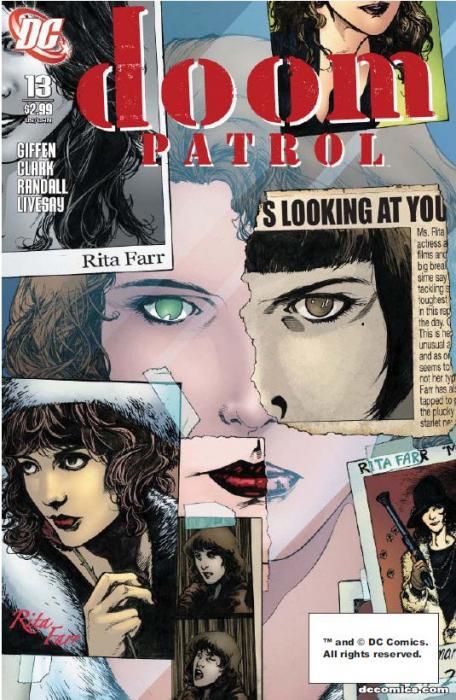Giffen tries to even the score by directing the spotlight to Rita Farr in this issue. Following the (not overly) startling revelation of Rita's condition in the previous issue, this issue examines how Rita came to be where she is and the circumstances that surround Rita rejoining the Doom Patrol following her apparent death in the original run of "Doom Patrol."
This issue is on par with "Doom Patrol" #6, which featured the "origin" of Negative Man and essentially compiled the absolute origin of Negative Man (Woman/Person) in all of his incarnations and had it all make sense. Here, however, Rita doesn't have the history of the Negative being. She does, however, have anger management issues, as well as a problematic relationship with her estranged husband who has manipulated Rita a little too much. Giffen writes this Rita as a character mired in self-doubt and stuck with a defeatist mindset, but she knows she can be better.
Rita's concerns and questions are keenly positioned against her relationships -- as a member of the core trio of the Doom Patrol, as a roommate to Bumblebee, and as an estranged, inflamed lover of Steve Dayton. Giffen does a thorough job with this process, and puts Rita in a position where she has control of who she is. The answers are a bit surprising, and I suspect Rita will find them surprising as well. I was (and will continue) to see Beast Boy in action with the DP.
I'm growing weary of Matthew Clark and Ron Randall sharing art chores on each issue. The two essentially have similar styles, but Clark's art tends to be a lot more expressive and frequently more thoroughly designed as a page. The montage of the Doom Patrol across the years is quite nice and an instant classic. Randall's art tends to be more stiff and prescribed to fit the whole. The two styles, when closely observed, don't mix as well in this issue as they did in previous. Maybe next issue will be all Clark, or at least more pages drawn by Matthew Clark.
Clark's art is stunningly raw, and in the case of "Doom Patrol," that needs to be so. There are scenes in Rita's story only Matthew Clark could have rendered should tussles. Clark makes Rita's struggle to understand herself and fit in look like the challenge of the year. Randall's art isn't dynamically inclined, but Randall does do a good job of telling the story on the page and it's clear that he is making an effort to mesh with Clark's style and work, but in some cases - check out the portrait of Rita wearing sunglasses on the eighth and eleventh pages of this issue.
The Doom Patrol has definitely seen its share of strife over the ages, and following their meeting with the Front Men last issue, they need an issue like this to get their heads together and recharge without having to take on another foe. That allows this issue to include some defining moments between Robotman and Negative Man and also between Rita and Steve "Mento" Dayton.
"Doom Patrol" has always been a niche book, and recent expectation was that this niche book wouldn't last much longer. If the art chores can get balanced out and the writing stays on par with this issue, the second year of "Doom Patrol" could be one of the best years yet. This issue, the thirteenth in this volume, is a surprisingly good issue for new (or lapsed) readers to join (or rejoin) in the wonder and merriment of "Doom Patrol."

